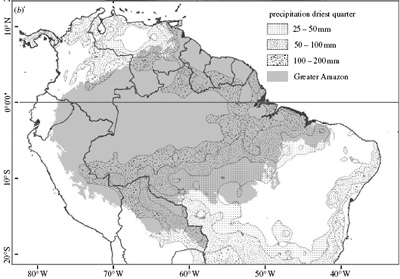Conservation strategies can mitigate the impact of global warming in the Amazon
Conservation strategies can mitigate the impact of global warming in the Amazon
Rhett A. Butler, mongabay.com
February 19, 2008
|
|
Careful design of protected areas to safeguard key “refugia” and allow for migration can increase the resilience of Amazon biodiversity to climate change, report researchers writing in Philosophical Transactions of the Royal Society B.
With the future climate of Amazonia largely uncertain, Timothy J. Killeen and Luis A. Solórzano argue that conservation corridors to allow species to shift their geographic range distributions in response to climate change should be a critical component for conservation planning in the region.
“Climate change is causing shifts in geographic patterns of the environment,” Dr. Solórzano, Senior Science Program Officer of the Gordon and Betty Moore Foundation, told mongabay.com. “Both empirical data and modeled predictions indicate that changes in global climate have important effects on the biosphere and is expected that biological systems will respond in different and often unpredictable ways; consequently, any long-term conservation planning effort needs to account for those potential effects, otherwise, today’s investments to preserve specific biodiversity targets might be useless within a few decades.”
 Core Amazon is defined by high precipitation and low seasonality. The areas at the greatest risk from future climate change are those in the southern and eastern Amazon with seasonal climate that could be shifted to a savannah-like climate. |
The authors propose a series to measures to improve the resiliency of conservation efforts in the Amazon, including surveying “future climatic tension zones” for “features that capture rain or conserve soil moisture to identify potential refugia for humid forest species”; protecting the western Amazon where the region’s highest level of biological richness is found and precipitation levels are less likely to shift due to climate change; establishing riparian corridors conserve both terrestrial and aquatic ecosystems; and safeguarding migration corridors like “river valleys which in the southern Amazon have an approximately North-South orientation, which will allow plant species to shift their distributions toward the equator.” Killeen and Solórzano also note the importance of altitudinal corridors and highlight the significance of soil variability to reduce drought stress and maintain plant biodiversity.
“Many of the steps necessary to develop a conservation strategy that addresses climate change are also components of traditional conservation strategies and would benefit conservation regardless of climate change,” they write.
Killeen and Solórzano say that mitigating the impact of planned infrastructure projects in the Amazon will be critical to developing an effective conservation strategy for the region. Highways, hydroelectric projects, hydrocarbon exploration, and other transportation projects threaten to undermine efforts to increase the resiliency of the Amazon to climate shifts and other changes.
Timothy J. Killeen and Luis A. Solórzano (2008). Conservation strategies to mitigate impacts from climate change in Amazonia [FREE OPEN ACCESS]. Phil. Trans. R. Soc. B, DOI: 10.1098/rstb.2007.0026